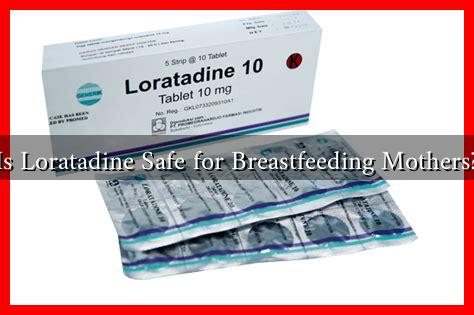-
Table of Contents
Is Loratadine Safe for Breastfeeding Mothers?
Breastfeeding is a critical period for both mothers and infants, and many new mothers often find themselves navigating the complexities of medication use during this time. One common medication that may come into question is loratadine, an antihistamine used to relieve allergy symptoms. This article explores the safety of loratadine for breastfeeding mothers, examining its effects on both the mother and the nursing infant.
Understanding Loratadine
Loratadine is a second-generation antihistamine that is commonly used to treat allergic rhinitis and chronic urticaria (hives). Unlike first-generation antihistamines, loratadine is less likely to cause sedation, making it a popular choice for those who need relief from allergy symptoms without the drowsiness associated with older medications.
Safety Profile of Loratadine During Breastfeeding
When considering the safety of loratadine for breastfeeding mothers, it is essential to look at how the drug is metabolized and its potential effects on breast milk and the nursing infant.
- Pharmacokinetics: Loratadine is rapidly absorbed and has a half-life of about 8 to 14 hours. It is primarily metabolized in the liver and excreted in urine.
- Breast Milk Transfer: Studies indicate that loratadine does pass into breast milk, but the concentrations are generally low. A study published in the journal Pediatrics found that the amount of loratadine in breast milk is significantly lower than the therapeutic dose for infants.
- Infant Exposure: The American Academy of Pediatrics classifies loratadine as a medication that is usually compatible with breastfeeding. The low levels found in breast milk suggest minimal risk to the nursing infant.
Case Studies and Research Findings
Several studies have investigated the effects of loratadine on breastfeeding mothers and their infants. For instance, a study conducted by the National Institutes of Health monitored breastfeeding mothers who took loratadine. The findings indicated that infants exposed to loratadine through breast milk did not show any adverse effects or significant changes in behavior or health.
Another research effort published in the journal Clinical Pharmacology & Therapeutics assessed the safety of various antihistamines during lactation. The results supported the conclusion that loratadine is one of the safer options for breastfeeding mothers, with no reported cases of sedation or other side effects in infants.
Considerations for Breastfeeding Mothers
While loratadine is generally considered safe, there are several factors that breastfeeding mothers should keep in mind:
- Consult Healthcare Providers: Always consult with a healthcare provider before starting any medication while breastfeeding.
- Monitor Infant Behavior: Pay attention to any changes in the infant’s behavior or health after taking loratadine.
- Timing of Doses: Taking loratadine just before breastfeeding may help minimize any potential exposure to the infant.
Conclusion
In summary, loratadine is generally considered safe for breastfeeding mothers, with minimal transfer to breast milk and low risk of adverse effects on nursing infants. The available research supports its use as a suitable option for managing allergy symptoms during lactation. However, it is crucial for mothers to consult healthcare providers before starting any medication and to monitor their infants for any unusual behavior. By taking these precautions, breastfeeding mothers can effectively manage their allergy symptoms while ensuring the safety and well-being of their infants.




